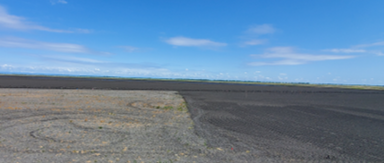- Author: Bruce A Linquist
- Editor: Consuelo Baez Vega
Last year roughly half of the rice acreage was left fallow. We have been conducting research (funded by the Rice Research Board) looking at the differences between rice grown after a fallow versus rice grown following rice. We have found that rice following a fallow has higher yield potential. In our two years of study we saw about a 2 to 3 sack yield advantage in rice after a fallow. Higher yields may be due to reduced disease incidence. In both years of the study we saw lower incidence of stem rot in rice following a fallow year. As mentioned, this can lead to higher yields but also to less lodging.
Regarding nitrogen management, we used a labeled nitrogen fertilizer to allow us to determine if the nitrogen in the plant came from fertilizer or from the soil. We found that fertilizer N was used similarly when rice followed a fallow or when it followed rice. Interestingly, we also found that when rice followed fallow, more nitrogen was available from the soil – particularly after PI. This has a couple of implications. First, it means if you had a fallow rice field last year, you may be able to back off on your overall N rate. In our data from one year, we found that you could back off by up 20 to 30 lb N/ac. Secondly, most of the additional N availability came after PI. This suggests that if you are routinely topdressing, it may not be necessary when rice is following a fallow year. Regardless, I would still suggest monitoring the crop at PI using a Leaf Color Chart or a GreenSeeker to make a more informed decision about N management.
Some of you may be asking “why do we get more nitrogen in a field that was fallowed?”. This is a great question. In fields that have been in rice where the rice straw is incorporated and flooded during the winter, phenols accumulate. Phenols are an organic compound that tend to build up when organic matter, such as straw, decomposes under anaerobic conditions. Given how most farmers manage their straw we would expect a build up of phenols. In fact, we have looked at soils around the valley and have found this to be the case. Phenols also bind nitrogen, making it unavailable for plants. Imposing long periods of time when the soil is aerobic such as during a fallow period, promotes the breakdown of these phenols and the release of nitrogen.
- Author: Whitney Brim-DeForest
It's that time again! If you would like to submit seeds for herbicide resistance testing, many weed species will be maturing right about now.
The UCCE Rice Weeds Program tests grower submitted seed samples of potentially herbicide-resistant watergrass species, sprangletop, smallflower umbrella sedge and bulrush. However, we encourage you to submit ANY species that you suspect to be resistant. We keep individual grower information confidential and any reporting of results will not identify individual growers.
Please fill out the form (linked here) for each weed seed sample (each field and/or species). The following tips will ensure that you receive the best possible results:
- The best timing of collection is when the seed easily falls off the seed head by gentle agitation in a paper bag (see video for demonstration):
o For watergrass species, this should be close to rice harvest (seeds should be brownish in color)
o For sprangletop, timing will be earlier, in August or September (seeds will appear greenish)
o For the sedges, timing may be as early as July, all the way through early September
o Smallflower umbrella sedge seed is yellow, with brown hulls (looks like dust)
o Bulrush (roughseed) seeds are black and have small hairs
- Seed should be collected from areas that you know have been sprayed with the suspected herbicide.
- Collect seeds from multiple plants, and the amount should be at least a few handfuls of seed, to ensure sufficient quantity for testing.
- Please do not collect seed from around field margins.
- Allow seed to dry in the paper bag to prevent molding.
Bring the sample and form to your local UCCE Farm Advisor (Whitney, Luis, or Michelle) or send or drop off samples at the Rice Experiment Station (RES) in Biggs. If you need assistance in collection, please contact your Farm Advisor or PCA. Results should be emailed to you in March of 2021.




